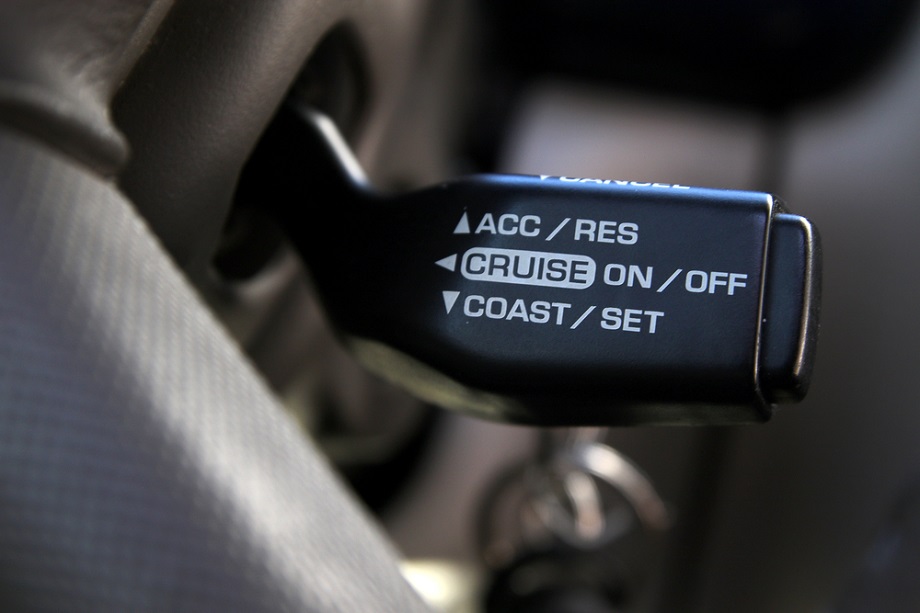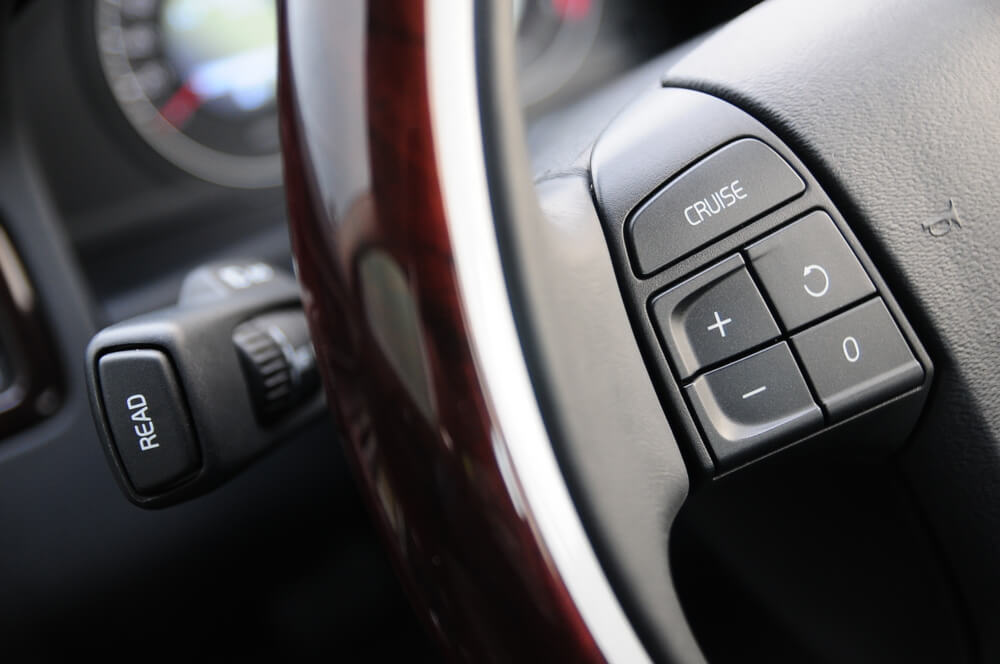 Written by Andrei Zakhareuski. With over 16 years of expertise, Andrei leads Driving-Tests.org, a top online resource for driver education. His leadership has established vital partnerships with over 2,600 libraries, educational bodies, and state agencies.
Written by Andrei Zakhareuski. With over 16 years of expertise, Andrei leads Driving-Tests.org, a top online resource for driver education. His leadership has established vital partnerships with over 2,600 libraries, educational bodies, and state agencies.
Understanding How the System Works
What is Cruise Control?
Cruise control is an electronic system that allows a vehicle to maintain a steady speed set by the driver. Cruise control is designed to be used on roadways without frequent stops. It’s ideal for use on highways and long stretches of road with minimal stops or turns.Types
- Standard cruise control maintains a set speed until manually overridden.
- Advanced systems, like adaptive cruise control, automatically adjust speed based on traffic conditions.
How to Use Cruise Control
- Setting Up
- Activating
- Adjusting Speed
Before activating cruise control, ensure conditions are safe. It’s not advisable to use cruise control in hazardous weather or heavy traffic.

Safety Tips
Be Alert
Remain vigilant and ready to deactivate cruise control instantly in case of an emergency or changing traffic conditions.
Speed Limits
Always adhere to speed limits. Cruise control should not be used to maintain speeds above legal limits.
Advanced Features
Adaptive Cruise Control
Adaptive Cruise Control
This modern feature uses sensors and radar to maintain a safe distance from the vehicle ahead, adjusting speed automatically.
Troubleshooting Common Issues
System Not Activating
System Not Activating
If your cruise control doesn’t activate, start with the basics. Ensure it’s turned on and you’re at the right speed (usually above 25-30 mph). If these aren’t the issues, it might be a blown fuse, a faulty brake pedal switch, or a defective speed sensor. Check your vehicle’s manual for fuse information and consider a professional inspection of the brake pedal switch and speed sensor.
Failing to Maintain Set Speed
Failing to Maintain Set Speed
Trouble maintaining the set speed often points to sensor issues. Speed sensors inform the cruise control system. If these sensors are dirty or malfunctioning, the system might not maintain the speed. Cleaning sensors and checking for obstructions can help. Also, consider checking wheel alignment and tire condition, as these can affect performance.
Erratic Speed Changes
Erratic Speed Changes
If your vehicle experiences erratic speed changes with cruise control engaged, this could indicate a problem with the throttle control system or the vehicle’s computer system. These complex issues generally require professional diagnostics and repair.
Adaptive Cruise Control Problems
Adaptive Cruise Control Problems
With adaptive cruise control, problems can arise from blocked sensors or system malfunctions. Ensure that the sensors, often located in the front grille or under the mirrors, are clean and unobstructed. For system malfunctions, professional diagnostics are essential, as these systems involve advanced electronics and software.
Comparative Analysis of Modern Cruise Control Systems
In the realm of modern vehicles, cruise control systems have evolved significantly, offering a range of functionalities tailored to enhance driving experience and safety. Here’s a comparative analysis of several popular systems.Tesla Full Self-Driving (FSD) Beta
Tesla Full Self-Driving (FSD) Beta
Tesla’s FSD Beta represents a leap forward in autonomous driving technology. It’s not just a cruise control system but an advanced driver-assistance system capable of navigating complex driving scenarios. Key features include automatic lane changes, stop sign and traffic light recognition, and the ability to navigate city streets. While it offers substantial automation, it still requires driver supervision and isn’t fully autonomous.
GM's Super Cruise
GM's Super Cruise
General Motors’ Super Cruise system is available in select Cadillac models and provides hands-free driving assistance on compatible highways. It uses LiDAR map data, high-precision GPS, and a driver attention system to ensure safety. Unlike Tesla’s FSD, it’s limited to highway use but excels in hands-free driving comfort and safety.
Ford Co-Pilot360
Ford Co-Pilot360
Ford’s Co-Pilot360 includes adaptive cruise control with stop-and-go and lane-centering. It’s less about hands-free driving and more about reducing driver fatigue and enhancing safety. This system is excellent for everyday driving, offering features like speed sign recognition and evasive steering assist.
Mercedes-Benz DRIVE PILOT
Mercedes-Benz DRIVE PILOT
Mercedes-Benz DRIVE PILOT system pushes towards Level 3 autonomy, allowing drivers to hand over control under certain conditions, like heavy traffic or on highways. It uses a sophisticated array of sensors and cameras, offering a smooth and intuitive driving experience. It’s more advanced than traditional systems but still requires driver attention.
BMW's Driving Assistant Professional
BMW's Driving Assistant Professional
BMW offers the Driving Assistant Professional system, which includes features like adaptive cruise control with stop-and-go, lane-keeping assistant, and traffic jam assistant. It’s designed for convenience and safety, providing a balanced mix of automation and driver control.
Real-World Impact
Cruise control technology not only adds convenience to driving but also significantly impacts safety and efficiency. This section delves into the real-world implications of using cruise control, supported by safety statistics and research findings. The integration of cruise control in vehicles has been a game-changer in terms of driving safety and efficiency. Here are some key impacts:- Reduced Driver Fatigue: Continuous concentration over long drives can lead to driver fatigue, a leading cause of road accidents. Cruise control allows drivers to maintain a constant speed without constant pedal adjustment, reducing the physical and mental strain during long journeys.
- Improved Fuel Efficiency: By maintaining a steady speed, cruise control helps in reducing fuel consumption. Studies have shown that erratic speed variations can lead to higher fuel consumption, whereas maintaining a consistent speed optimizes fuel efficiency.
- Safety Statistics: Research indicates that the use of cruise control can lead to a reduction in speed-related accidents. However, it’s crucial to note that over-reliance on cruise control in inappropriate conditions (like city driving or in heavy traffic) can negate these safety benefits.
- Impact on Traffic Flow: When used widely, cruise control can contribute to smoother traffic flow on highways. Consistent speeds help in reducing the frequency of braking and acceleration among vehicles, leading to less congestion and smoother traffic movement.
For a deeper understanding of cruise control and its various aspects, it’s always beneficial to refer to your vehicle’s manual and seek guidance from automotive professionals.